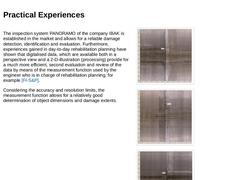
|
The inspection system PANORAMO of the company IBAK is established in the market and allows for a reliable damage detection, identification and evaluation. Furthermore, experiences gained in day-to-day rehabilitation planning have shown that digitalised data, which are available both in a perspective view and a 2-D-illustration (processing) provide for a much more efficient, second evaluation and review of the data by means of the measurement function … |

|
(Image: Picto Unterhalt) A survey answered by users of the system [PANO2004] showed that, compared to standard pan and tilt cameras, the inspection performance of the PANORAMO inspection systems is up 100 % higher, resulting in a higher efficiency at an appropriate degree of utilisation. The tasks of the inspector are limited to the insertion and extraction of the camera and the monitoring of its functions during the inspection. The damages are coded … |
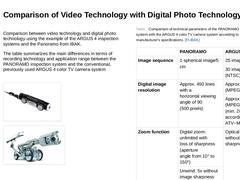
|
Comparison between video technology and digital photo technology using the example of the ARGUS 4 inspection systems and the Panoramo from IBAK. The table summarizes the main differences in terms of recording technology and application range between the PANORAMO inspection system and the conventional, previously used ARGUS 4 color TV camera system (Image: Inspection system PANORAMO) (Image: Height adjustable trolley with side guide for oval pipes) (… |
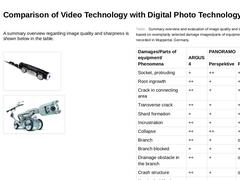
|
A summary overview regarding image quality and sharpness is shown below in the table. (Image: Inspection system PANORAMO) (Image: Height adjustable trolley with side guide for oval pipes) (Table: Summary overview and evaluation of image quality and sharpness based on exemplarily selected damages/parts of equipment/phenomena recorded in Wuppertal, Germany) |
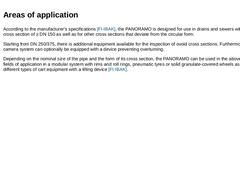
|
According to the manufacturer’s specifications [FI-IBAK], the PANORAMO is designed for use in drains and sewers with a circular cross section of ≥ DN 150 as well as for other cross sections that deviate from the circular form. Starting from DN 250/375, there is additional equipment available for the inspection of ovoid cross sections. Furthermore, the camera system can optionally be equipped with a device preventing overturning. Depending on the nominal … |
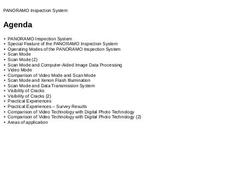
|
|
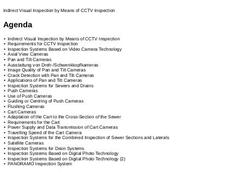
|
|
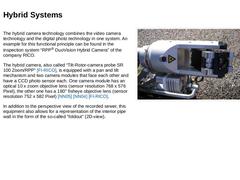
|
The hybrid camera technology combines the video camera technology and the digital photo technology in one system. An example for this functional principle can be found in the inspection system “RPP® DuoVision Hybrid Camera” of the company RICO. The hybrid camera, also called “Tilt-Rotor-camera probe SR 100 Zoom/RPP” [FI-RICO], is equipped with a pan and tilt mechanism and two camera modules that face each other and have a CCD photo sensor each. One … |
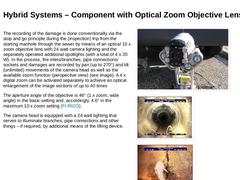
|
The recording of the damage is done conventionally via the stop and go principle during the (inspection) trip from the starting manhole through the sewer by means of an optical 10 x zoom objective lens with 24 watt camera lighting and the separately operated additional spotlights (with a total of 4 x 20 W). In the process, the inlets/branches, pipe connections/sockets and damages are recorded by pan (up to 270°) and tilt (unlimited) movements of … |
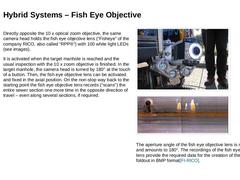
|
Directly opposite the 10 x optical zoom objective, the same camera head holds the fish eye objective lens (“Fisheye” of the company RICO, also called “RPP®”) with 100 white light LEDs (see images). It is activated when the target manhole is reached and the usual inspection with the 10 x zoom objective is finished. In the target manhole, the camera head is turned by 180° at the touch of a button. Then, the fish eye objective lens can be activated and … |
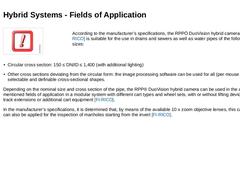
|
According to the manufacturer’s specifications, the RPPÒ DuoVision hybrid camera system [FI-RICO] is suitable for the use in drains and sewers as well as water pipes of the following nominal sizes: -
Circular cross section: 150 ≤ DN/ID ≤ 1,400 (with additional lighting)
-
Other cross sections deviating from the circular form: the image processing software can be used for all (per mouse click) freely selectable and definable cross-sectional …
|
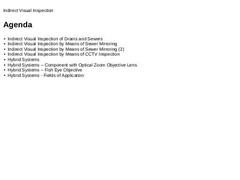
|
|
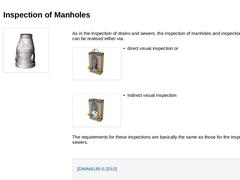
|
(Image: Picto Dichtheit Schacht) As in the inspection of drains and sewers, the inspection of manholes and inspection chambers can be realised either via: (Image: Pictogram Direct visual inspection) -
direct visual inspection or
(Image: Pictogram Indirect visual inspection) -
indirect visual inspection
The requirements for these inspections are basically the same as those for the inspection of sewers. |
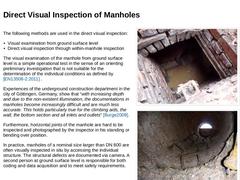
|
The following methods are used in the direct visual inspection: -
Visual examination from ground surface level
-
Direct visual inspection through within-manhole inspection
The visual examination of the manhole from ground surface level is a simple operational test in the sense of an orienting preliminary investigation that is not suitable for the determination of the individual conditions as defined by [EN13508-2:2011] . Experiences of the underground … |
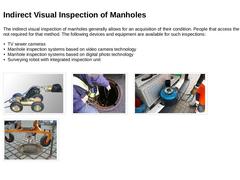
|
The indirect visual inspection of manholes generally allows for an acquisition of their condition. People that access the manhole are not required for that method. The following devices and equipment are available for such inspections: -
TV sewer cameras
-
Manhole inspection systems based on video camera technology
-
Manhole inspection systems based on digital photo technology
-
Surveying robot with integrated inspection unit
(Image: TV-Kanalkamera) (… |
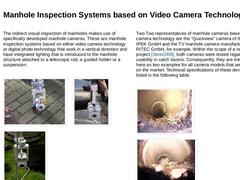
|
The indirect visual inspection of manholes makes use of specifically developed manhole cameras. These are manhole inspection systems based on either video camera technology or digital photo technology that work in a vertical direction and have integrated lighting that is introduced to the manhole structure attached to a telescopic rod, a guided holder or a suspension. (Image: TV manhole camera of the company IPEK) (Image: TV Manhole camera of the … |
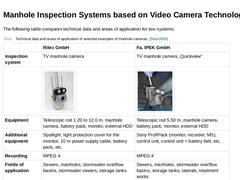
|
The following table compares technical data and areas of application for two systems. (Table: Technical data and areas of application of selected examples of manhole cameras) |
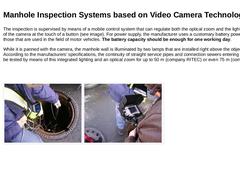
|
The inspection is supervised by means of a mobile control system that can regulate both the optical zoom and the lighting intensity of the camera at the touch of a button (see image). For power supply, the manufacturer uses a customary battery power pack like those that are used in the field of motor vehicles. The battery capacity should be enough for one working day. While it is panned with the camera, the manhole wall is illuminated by two lamps … |
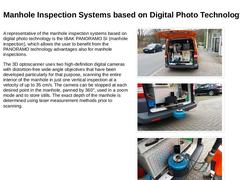
|
A representative of the manhole inspection systems based on digital photo technology is the IBAK PANORAMO SI (manhole inspection), which allows the user to benefit from the PANORAMO technology advantages also for manhole inspections. The 3D optoscanner uses two high-definition digital cameras with distortion-free wide-angle objectives that have been developed particularly for that purpose, scanning the entire interior of the manhole in just one vertical … |
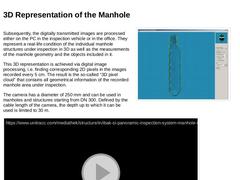
|
Subsequently, the digitally transmitted images are processed either on the PC in the inspection vehicle or in the office. They represent a real-life condition of the individual manhole structures under inspection in 3D as well as the measurements of the manhole geometry and the objects included in it. This 3D representation is achieved via digital image processing, i.e. finding corresponding 2D pixels in the images recorded every 5 cm. The result … |
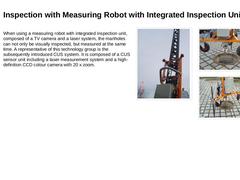
|
When using a measuring robot with integrated inspection unit, composed of a TV camera and a laser system, the manholes can not only be visually inspected, but measured at the same time. A representative of this technology group is the subsequently introduced CUS system. It is composed of a CUS sensor unit including a laser measurement system and a high-definition CCD colour camera with 20 x zoom. (Image: Measuring robot with integrated inspection … |
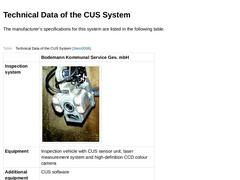
|
The manufacturer’s specifications for this system are listed in the following table. (Table: Technical Data of the CUS System ) |
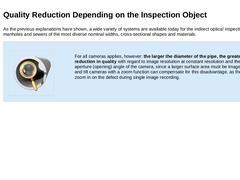
|
As the previous explanations have shown, a wide variety of systems are available today for the indirect optical inspection of manholes and sewers of the most diverse nominal widths, cross-sectional shapes and materials. (Image: Picto Inspektion) For all cameras applies, however: the larger the diameter of the pipe, the greater the reduction in quality with regard to image resolution at constant resolution and the same aperture (opening) angle of the … |

|
In the case of cameras with analogue image transmission: -
Cameras with analogue image transmission should be equipped with an objective lens to capture a sufficient depth of field ranging from 0.1 to at least 1.5 m,
-
The camera lens should have a remote-controllable automatic focusing ranging from 1 cm to infinite, and,
-
When it is used in sewers ≥ DN 200, have an optical zoom (at least 10 x).
For scanners, the depth of field of the camera objective … |
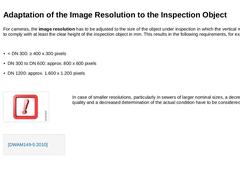
|
For cameras, the image resolution has to be adjusted to the size of the object under inspection in which the vertical resolution has to comply with at least the clear height of the inspection object in mm. This results in the following requirements, for example: -
< DN 300: ≥ 400 x 300 pixels
-
DN 300 to DN 600: approx. 800 x 600 pixels
-
DN 1200: approx. 1.600 x 1.200 pixels
In case of smaller resolutions, particularly in sewers of larger … |